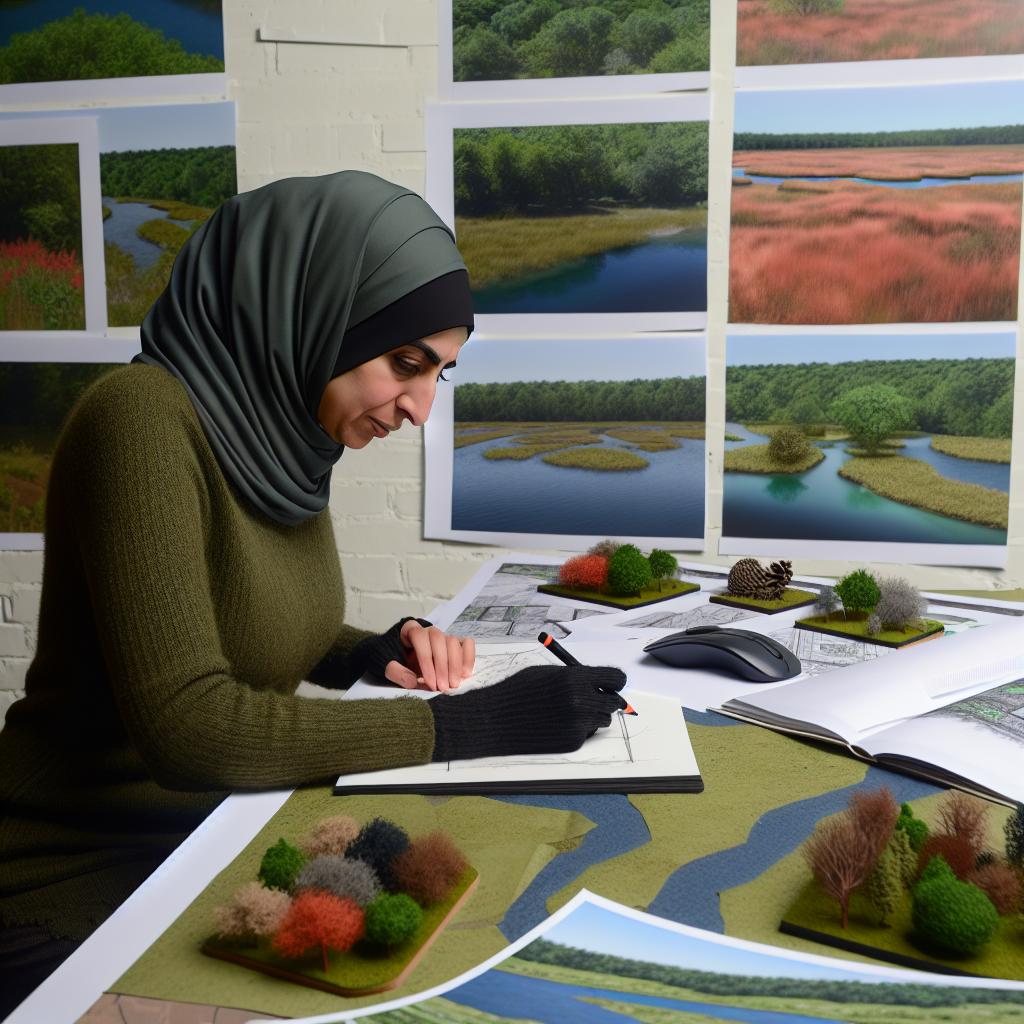Introduction:
A brief overview of the importance of incorporating wildlife habitats into landscape designs is essential.
It not only enhances the aesthetic appeal of the outdoor environment but also plays a crucial role in promoting biodiversity.
Biodiversity is the key to maintaining a healthy ecosystem as it ensures the balance of various plant and animal species.
By creating habitats for wildlife within landscape designs, we can support the natural processes that sustain life on our planet.
This includes providing food sources, shelter, and breeding grounds for a wide range of native species.
Additionally, incorporating wildlife habitats into landscape designs helps to create sustainable environments that can adapt to changing climatic conditions.
This is essential for ensuring the long-term health and resilience of ecosystems.
Overall, integrating wildlife habitats into landscape designs is a proactive approach to conservation that benefits both wildlife and the environment as a whole.
Research:
– Discuss different types of wildlife habitats that can be incorporated into landscape designs.
– Importance of understanding local wildlife species and their habitat needs.
– Consideration of the specific needs of pollinators, birds, and other wildlife.
When incorporating wildlife habitats into landscape designs, it is essential to consider the specific needs of different types of wildlife.
Understanding the local wildlife species and their habitat requirements is crucial in creating a sustainable and thriving ecosystem within a designed landscape.
Different Types of Wildlife Habitats:
There are various types of wildlife habitats that can be incorporated into landscape designs, such as:
- Wetlands: These habitats are essential for supporting a diverse range of plant and animal species, including amphibians, birds, and insects.
- Woodlands: Woodland habitats provide shelter and nesting sites for various wildlife, including mammals, birds, and invertebrates.
- Grasslands: Grasslands are crucial for supporting pollinators, birds, and small mammals, as well as providing food sources for many wildlife species.
Understanding Local Wildlife Species:
It is important to research and understand the local wildlife species in the area where the landscape design will be implemented.
This knowledge will help in determining the specific habitat requirements of different wildlife and ensuring that the design supports their needs.
Specific Needs of Pollinators, Birds, and Other Wildlife:
- Pollinators: Incorporate native plants that attract pollinators, such as bees and butterflies, by providing nectar and pollen-rich flowers.
- Birds: Provide habitat elements such as bird feeders, birdhouses, and water sources to attract and support a diverse range of bird species.
- Other Wildlife: Consider the nesting, food, and shelter needs of other wildlife species, such as small mammals, reptiles, and amphibians, and incorporate suitable habitat elements into the design.
By incorporating wildlife habitats into landscape designs and considering the specific needs of pollinators, birds, and other wildlife, designers can create sustainable and biodiverse environments that support and enhance local wildlife populations.
This approach not only benefits wildlife but also contributes to the overall health and resilience of ecosystems.
Planning:
– Assessing the existing landscape and identifying opportunities for creating wildlife habitats: Before incorporating habitats, evaluate the current environment.
– Deciding on the type of habitat(s) to incorporate based on research findings: Research the local wildlife species to determine appropriate habitat.
Transform Your Career Today
Unlock a personalized career strategy that drives real results. Get tailored advice and a roadmap designed just for you.
Start Now– Consideration of factors such as water sources, shelter, and food availability for wildlife: Ensure habitats provide essential resources for various species.
Implementation:
– Selecting native plants that attract wildlife: Choose plants that provide food, shelter, and nesting sites.
– Incorporating water features like birdbaths or ponds: Offer drinking and bathing opportunities for animals.
– Building nest boxes and shelters for different wildlife: Provide safe spaces for nesting, roosting, and shelter.
Maintenance:
– Regularly monitoring and replenishing food and water sources: Ensure a constant supply of resources for wildlife.
– Pruning and trimming plants to maintain habitats: Keep the landscape healthy and accessible for animals.
– Managing pests organically to protect wildlife habitats: Avoid harmful chemicals that can harm wildlife species.
Evaluation:
– Observing and documenting wildlife activity in the new habitats: Track how animals utilize and interact with the landscape.
– Soliciting feedback from local wildlife experts or organizations: Get input on habitat effectiveness and potential improvements.
– Making adjustments based on feedback and monitoring results: Adapt habitats to better suit wildlife needs and behaviors.
Explore Further: Pipelayer Workwear: Essential Gear and Apparel
Design:
When creating a design plan, consider the layout of the landscape to integrate wildlife habitats seamlessly.
Include a variety of native plants that provide food and shelter for wildlife species.
Implement features such as bird feeders, bird baths, and insect hotels for attracting different wildlife species.
Why Design Matters:
Proper design ensures that wildlife habitats are incorporated effectively without disrupting the overall aesthetics.
Native plants help attract local wildlife species, promoting biodiversity and ecosystem health.
Features like bird feeders and insect hotels create opportunities for wildlife interaction, observation, and conservation.
Tips for Designing Wildlife Habitats:
Research local wildlife species to understand their habitat needs and preferences.
Choose plants that bloom at different times to provide food sources year-round.
Showcase Your Business Today
Reach thousands of readers actively exploring professional services. Publish your business profile and grow your audience now.
Publish NowCreate a water source like a small pond or birdbath to attract birds and insects.
Case Studies:
Example 1: A garden designed with native flowers and bushes attracted butterflies and bees.
Example 2: A backyard with a bird feeder and bath became a popular spot for local bird species.
Example 3: An insect hotel installed in a community garden increased insect biodiversity.
Benefits of Integrating Wildlife Features:
Incorporating wildlife habitats into landscape designs is not only beneficial for the environment but also adds beauty and diversity to any outdoor space.
By following these design principles and examples, you can create a harmonious environment that benefits both wildlife and humans.
See Related Content: Training Programs for Aspiring Insulation Workers
When it comes to incorporating wildlife habitats into landscape designs, the installation process plays a crucial role in creating a thriving ecosystem for native species.
Here are some key aspects to consider:
Proper Planting Techniques
One of the first steps in creating a wildlife-friendly habitat is ensuring that native plants are properly installed.
This involves using appropriate planting techniques that support the growth and longevity of the vegetation.
For example, selecting the right location, preparing the soil, and providing adequate water and nutrients are essential for the success of native plants.
Wildlife-Friendly Features
In addition to selecting native plants, incorporating wildlife-friendly features such as water sources and shelter can further enhance the habitat.
Water sources, such as birdbaths or small ponds, can attract a variety of wildlife, including birds, insects, and amphibians.
Similarly, providing shelter in the form of nesting boxes, brush piles, or rock piles can offer refuge and breeding sites for different species.
Alignment with Landscape Design Aesthetic
While creating a wildlife habitat within a landscape design, it is essential to ensure that the overall aesthetic of the design is maintained.
This can be achieved by integrating habitat features seamlessly into the existing landscape, such as incorporating natural materials like rocks, logs, or native plantings.
By blending the habitat design with the overall landscape design, you can create a harmonious and visually appealing outdoor space that also supports local wildlife.
Uncover the Details: Cost Breakdown: Professional vs. DIY Window Cleaning

Maintenance:
- Regular monitoring of the habitat to ensure its success
- Pruning and weeding to maintain plant health and growth
- Refilling bird feeders and water sources as needed
Creating a wildlife habitat in your landscape design is a rewarding endeavor that benefits both your local ecosystem and the overall beauty of your outdoor space.
However, it’s important to remember that maintaining a wildlife habitat requires ongoing care and attention to ensure its success.
Regular Monitoring
One key aspect of maintaining a wildlife habitat is regular monitoring to assess its health and success.
This involves observing the behavior of wildlife visitors, checking for any signs of distress or decline in plant life, and making necessary adjustments to support the habitat’s overall well-being.
By staying attentive to the habitat’s needs, you can address any issues promptly and ensure its continued success.
Pruning and Weeding
Another essential maintenance task for a wildlife habitat is pruning and weeding to maintain plant health and growth.
Overgrown vegetation can overcrowd the habitat and limit its ability to support a diverse range of wildlife.
Regular pruning helps to promote healthy plant growth and create a more balanced ecosystem for local wildlife to thrive in.
Similarly, removing weeds helps to prevent competition for resources and ensures that native plants can flourish.
Refilling Bird Feeders and Water Sources
Providing a reliable food source is crucial for attracting and supporting a variety of bird species in your wildlife habitat.
Regularly refilling bird feeders with high-quality birdseed and cleaning feeders to prevent mold and bacteria buildup will help to attract a diverse range of bird species to your landscape.
In addition, maintaining clean and fresh water sources such as birdbaths or ponds is essential for providing drinking and bathing opportunities for wildlife.
Regularly cleaning and refilling water sources will ensure that birds and other wildlife have access to clean water year-round.
Incorporating wildlife habitats into landscape designs not only adds beauty and interest to your outdoor space but also plays a vital role in supporting local wildlife populations.
By following these maintenance tips, you can create a thriving wildlife habitat that provides a safe and nurturing environment for a variety of species to enjoy.
Gain More Insights: Green Building: Eco-Friendly Drywall Options
Benefits:
Increased biodiversity and wildlife presence in the landscape.
Positive impact on local ecosystems and wildlife populations.
Creating a more sustainable and ecologically friendly landscape design.
How to Incorporate Wildlife Habitats into Landscape Designs
When designing a landscape, it’s essential to consider wildlife habitats to enhance biodiversity and create a more sustainable environment.
Selecting Native Plants
One way to attract wildlife to your landscape is by incorporating native plants that provide food, shelter, and nesting sites for local wildlife species.
Showcase Your Business Today
Reach thousands of readers actively exploring professional services. Publish your business profile and grow your audience now.
Publish NowNative plants are well-adapted to the local climate and soil conditions, making them ideal choices for creating wildlife habitats.
Creating Water Sources
Including water features such as ponds, bird baths, or small streams in your landscape design can attract a variety of wildlife, including birds, amphibians, and insects.
Water sources provide animals with a vital resource for drinking and bathing, making them a valuable addition to any wildlife habitat.
Building Habitat Structures
Installing birdhouses, bat boxes, or bee hotels can provide additional shelter and nesting sites for wildlife in your landscape.
These structures mimic natural habitats and help support local wildlife populations by providing safe spots for them to rest and raise their young.
Minimizing Chemical Use
Reducing or eliminating the use of pesticides and herbicides in your landscape can help create a healthier environment for wildlife.
Chemicals can have harmful effects on wildlife populations, so opting for natural or organic alternatives can benefit both wildlife and the ecosystem as a whole.
Designing Wildlife Corridors
Creating interconnected pathways or green spaces in your landscape can help wildlife move more freely between habitats.
Wildlife corridors allow animals to access essential resources, such as food, water, and shelter, while also reducing the risk of isolation and genetic decline among species.
Providing Nesting Sites
Incorporating features like brush piles, rock walls, or fallen logs can offer nesting opportunities for various wildlife species.
These natural elements create inviting habitats for animals to seek refuge, raise their young, and find protection from predators.
Enhancing Pollinator Habitats
Including flowering plants that attract bees, butterflies, and other pollinators can help support essential wildlife populations in your landscape.
Pollinators play a crucial role in plant reproduction and biodiversity, making them valuable contributors to a healthy ecosystem.
By implementing these strategies and incorporating wildlife habitats into your landscape design, you can increase biodiversity, support local wildlife populations, and create a more sustainable and ecologically friendly environment for both humans and animals to enjoy.
Wildlife Habitats in Landscape Design
Incorporating wildlife habitats into landscape designs is essential for overall ecosystem health.
Consider integrating wildlife habitats into your landscape to support local biodiversity.
Creating wildlife-friendly spaces positively impacts the environment and local wildlife populations.
Additional Resources
Beneficial Management Practices: Avoiding, Minimizing, and …
[E-Books for Sale]
The Big Book of 500 High-Paying Jobs in America: Unlock Your Earning Potential
$19.99 • 500 High-Paying Jobs • 330 pages
Explore 500 high-paying jobs in America and learn how to boost your career, earn more, and achieve success!
See All 500 High-Paying Jobs of this E-Book
1001 Professions Without a Degree: High-Paying American Jobs You Can Start Now
$19.99 • 1001 Professions Without a Degree • 174 pages
Discover 1001 high-paying jobs without a degree! Unlock career tips, skills, and success strategies for just $19.99!




